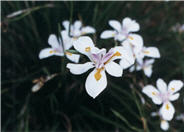
Common name:Nandina, Heavenly Bamboo
Botanical name:Nandina domestica
Nandina domestica is a graceful upright shrub that grows from 3'-6' in height. It gets its name from its bamboo-like growth habit. When thinned from the center it bears a remarkable resemblance to bamboo. It is best used in groups. It can be used in a shaded patio or out in a shrub border with full sun. An interesting feature of Heavenly Bamboo is the bronze color in the new growth when planted in full sun. It also bears clusters of white flowers in the spring.

Common name:Sea Pink, Common Thrift
Botanical name:Armeria maritima
This clumping, grass-like perennial is native to many areas, including coastal California. Its flowers range from deep rose pink through white. -Monterey Bay Nursery

Common name:Freeway Daisy, Trailing African Dai
Botanical name:Osteospermum fruticosum
This groundcover-small shrub will grow 1' tall, spreading 4' in a year. It has medium-size green leaves with lavender that have a dark purple center. The flower color changes to white the next day! The flowers bloom in fall and winter but in mild coastal areas, may bloom all year. It needs well draining soil. This plant looks great on a hillside or in a hanging basket.

Common name:Butterfly Iris or Fortnight Lily
Botanical name:Dietes iridioides
This clumping evergreen iris bears tall, narrow leaves to 30" tall and white flowers marked purple in the center on stalks to 3' tall, appearing spring through fall. This variety has stiffer, darker foiliage than the bicolor form. It requires sun to part shade with little or no summer watering when established. This is a very reliable plant. Divide every 3-5 years to keep it looking fresh.

Common name:Snow-In-Summer
Botanical name:Cerastium tomentosum
Masses of snow white flowers highlight this plant during the early summer season. This attractive ground cover is a great filler among other plants and rocks. Foliage is silver gray or gray/green and is woolly. This plant tolerates coastal conditions and desert areas. Use in rock settings, in hanging baskets, containers, or as a lawn substitute. Cut back in fall to refresh plant.

Common name:Tobira
Botanical name:Pittosporum tobira
This large, dense, evergreen shrub or small tree has shiny dark green leaves. In the spring, clusters of small, cream-colored flowers appear with the fragrance of orange blossoms. Mock Orange can be grown in full sun or partial shade. It is considered one of the most durable shrubs in California landscapes.

Common name:Copper King Gazania
Botanical name:Gazania 'Copper King'
This perennial groundcover will grow 6"-10" tall and has soft, greyish-green foliage with yellow-orange flowers that bloom April to September.

Common name:Blue Fescue, Blue Fescue Grass
Botanical name:Festuca glauca
This ground cover/grass will grow less than 1' tall and has small, blue-green, evergreen leaves that are very thin and hair-like. Flowers appear in the summer but are insignificant. This dependable ground cover prefers full sun in coastal areas and afternoon shade in warm inland areas. It needs well draining soil and is drought tolerant once it's established. Leaves may burn during the summer but trim in winter to keep it looking refreshed.

Common name:Semi-trailing Yellow Gazania
Botanical name:Gazania 'Mitsuwa Yellow'
This somewhat hardy perennial will grow 6"-12" high, spreading 3' wide. It produces wonderful, bright yellow flowers during the warm season. Plant in full sun. It is drought tolerant once it's established. This is a great ground cover for erosion control on hillsides or used as a lawn substitute.
In the natural world the endless cycle of birth, growth, decay, death and rebirth flows throughout the seasons. Plants die, leaves fall and new growth springs up in its place. Nothing is lost and the fallen leaves and dead plants decay into the soil, enriching it for the next generation of growth.
Click in the green box for more information
Designer:
Photographer: GardenSoft
Physical weed control, including mulching, or hand removal protects the watershed from harmful chemicals.
Develop healthy soil for plants that are vigorous and naturally pest-resistant.